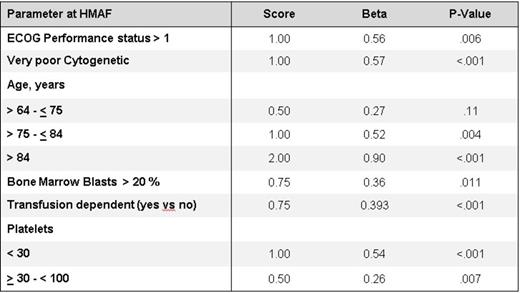Abstract
Background:
Several validated prognostic models exist for patients (pts) with myelodysplastic syndromes (MDS), including the International Prognostic Scoring System (IPSS), the Revised IPSS (IPSS-R), the World Health Organization (WHO) classification-based Prognostic Scoring System (WPSS), and the MD Anderson Prognostic Scoring System (MDAPSS). All were developed in pts with newly diagnosed MDS, and their prognostic value in subsequent stages of disease, such as at the time of hypomethylating agents failure (HMAs, azacitidine (AZA) and decitabine (DAC), has not been established. Despite this, the IPSS and IPSS-R is often used to determine clinical trial eligibility for pts who fail HMA and has been used by the FDA for drug labeling in this setting. Here in we developed a new prognostic model that predicts outcome post HMAs failure (HMAF).
Methods
Included patients were diagnosed with higher-risk MDS (per 2008 WHO criteria, higher-risk defined as IPSS Intermediate-2/High) with clinical and pathologic data entered into the MDS Clinical Research Consortium database. The IPSS, IPSS-R, WPSS and MDAPSS were calculated at the time of diagnosis and HMAF. HMAF was defined as no response to AZA or DAC following >4 cycles, loss of response, or progression to acute myeloid leukemia (AML) at any time after starting therapy. Responses were defined per International Working Group criteria (IWG 2006). Overall survival (OS) was calculated from the time of diagnosis to time of death or last follow up when the models were applied at diagnosis and from HMAF date to time of death or last follows up when the models were applied at the time of HMAF. Cox proportional hazard analysis within the multivariable model-building with fractional polynomials (MFP) approach, which automatically select from all factors at the time of HMAF, was used to build the new model. Akaike information criterion (AIC) was used to compare fits from Cox proportional hazards models.
Results
Of 450 higher-risk MDS pts who failed HMAs, 311 (69.1%) were treated with AZA and 139 (30.9%) with DAC. The median age at diagnosis was 70 years (range: 35-91). Best responses (BR) to HMA were: 96 (21.3%) with complete remission, 40 (8.9%) partial remission, 46 (10.2%) hematologic improvement, 180 (40.0%) stable disease, and 88 (19.6%) with progressive disease. The median number of cycles received during treatment was 6 (range, 2-51). With a median follow up of 17.4 months (IQ range, 16.1, 18.7), the median OS from diagnosis for the entire group was 18.5 months (IQ range, 17.2, 19.8). Median OS from diagnosis was similar for patients treated with AZA compared to DAC (18.0 months vs. 20.3 months, p = .36). The median OS after HMAF was 7.3 months (IQ range, 6.3, 8.4). Survival plots for each prognostic scoring system at diagnosis and HMAF are shown in Figure 1. Comparing the predictive power of these scoring systems at the time of HMAF, the AICc for each model was: MDASS (3541.1); IPSS-R (3562.0), IPSS (3570.0), and WPSS with AICc of (3572.2) (lower AICc indicates better fit of the model). Given the lower predictive power of the current prognostic models at the time of HMAF, we developed a new prognostic model specific for this patient population. Our MFP modeling approach selected 6 factors that have significant association with OS at the time of HMAF in the final Cox multivariate model (Table 1). The new model identified two risk groups: Low: score < 2.25, median OS 11.0 months (95% CI 8.8-13.6) and a high risk group with score of > 2.25 and median OS 4.5 months (95% CI 3.9-5.3). Using the internal model validation assessment, the estimated AICc for the new model was 3520.4 (lowest AICc). When the new model was applied at time of diagnosis, the AICc decreased to 3515.1, a much smaller decrease compared to the existing prognostic systems built at diagnosis: MDASS (3515.7), IPSS-R (3528.2), WPSS (3537.5) and IPSS (3537.7).
Conclusion
Currently available MDS prognostic scoring systems should be used cautiously in pts at the time of HMAF and, given their inconsistent reliability, should be avoided for clinical trial eligibility or drug labeling. A new prognostic model was developed specific for this patient population.
Overall survival by scoring systems at diagnosis and at the time of HMA failure
Komrokji:Celgene: Consultancy, Research Funding; Incite: Consultancy; Novartis: Speakers Bureau; GSK: Research Funding. Steensma:Celgene: Consultancy; Amgen: Consultancy; Incyte: Consultancy; Onconova: Consultancy. Padron:Novartis: Speakers Bureau; Incyte: Research Funding. List:Celgene Corporation: Honoraria, Research Funding. Sekeres:TetraLogic: Membership on an entity's Board of Directors or advisory committees; Celgene Corporation: Membership on an entity's Board of Directors or advisory committees; Amgen: Membership on an entity's Board of Directors or advisory committees.
Author notes
Asterisk with author names denotes non-ASH members.



This feature is available to Subscribers Only
Sign In or Create an Account Close Modal